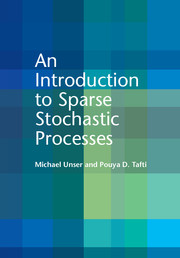Book contents
- Frontmatter
- Dedication
- Contents
- Preface
- Notation
- 1 Introduction
- 2 Roadmap to the book
- 3 Mathematical context and background
- 4 Continuous-domain innovation models
- 5 Operators and their inverses
- 6 Splines and wavelets
- 7 Sparse stochastic processes
- 8 Sparse representations
- 9 Infinite divisibility and transform-domain statistics
- 10 Recovery of sparse signals
- 11 Wavelet-domain methods
- 12 Conclusion
- Appendix A Singular integrals
- Appendix B Positive definiteness
- Appendix C Special functions
- References
- Index
9 - Infinite divisibility and transform-domain statistics
Published online by Cambridge University Press: 05 September 2014
- Frontmatter
- Dedication
- Contents
- Preface
- Notation
- 1 Introduction
- 2 Roadmap to the book
- 3 Mathematical context and background
- 4 Continuous-domain innovation models
- 5 Operators and their inverses
- 6 Splines and wavelets
- 7 Sparse stochastic processes
- 8 Sparse representations
- 9 Infinite divisibility and transform-domain statistics
- 10 Recovery of sparse signals
- 11 Wavelet-domain methods
- 12 Conclusion
- Appendix A Singular integrals
- Appendix B Positive definiteness
- Appendix C Special functions
- References
- Index
Summary
As we saw in Chapter 8, we have at our disposal two primary tools to analyze/characterize sparse signals: (1) the construction of the generalized-increment process by application of the discrete version of the whitening operator (localization), and (2) a wavelet analysis using operator-like basis functions. The goal shared by the two approaches is to approximately recover the innovations by numerical inversion of the signal-generation model. While the localization option appears to give the finest level of control, the wavelet option is interesting as well because of its greater robustness to modeling errors. Indeed, performing a wavelet transform (especially if it is orthogonal) is a much stabler operation than taking a discrete derivative, which tends to amplify high-frequency perturbations.
In this chapter, we take advantage of our functional framework to gain a better understanding of the true nature of the transform-domain statistics. Our investigation revolves around the fact that the marginal pdfs are infinitely divisible (id) and that they can be determined explicitly via the analysis of a common white noise (innovation).We make use of this result to examine a number of relevant properties of the underlying id distributions and to show that they are, for the most part, invariant to the actual shape of the analysis window. This implies, among other things, that the qualitative effect of operator-like filtering is the same in both analysis scenarios, in the sense that the sparsity pattern of the innovation is essentially preserved.
- Type
- Chapter
- Information
- An Introduction to Sparse Stochastic Processes , pp. 223 - 247Publisher: Cambridge University PressPrint publication year: 2014



